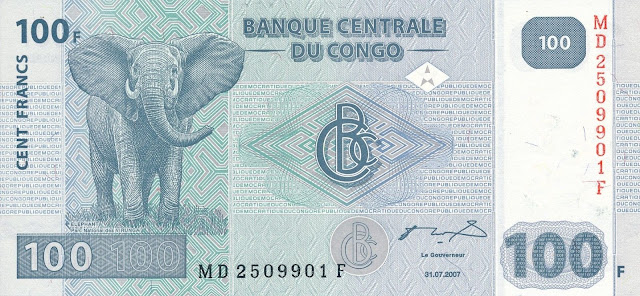Congo Democratic Republic 100 Congolese francs banknote 2007 Elephant
Central Bank of the Congo - Banque Centrale du Congo
Obverse: African Bush Elephant (Loxodonta africana) at Virunga National Park; Monogram of the Central Bank of Congo at center.Reverse: High voltage power lines. Inga II hydroelectric dam and power station on Congo River.
Watermark: Head of an Okapi (Okapia johnstoni) - relative of a giraffe that resembles a zebra.
Main colour: Slate blue.
Signature: Jean-Claude Masangu-Mulongo (Le Gouverneur).
Date of Issue: 31 July 2007.
Printed by Hotel des Monnaies, B.C.C., Kinshasa, R.D.C.
Dimensions: 151 x 69 mm
Signature of Jean-Claude Masangu Mulongo (as LE GOUVERNEUR). Solid security thread with demetalized text. 5-pointed star as registration device. One horizontal and one vertical 7-digit serial number on front, both having a double letter prefix, a single letter suffix and numerals of the same size.
Texts: République Démocratique du Congo. Banque Centrale du Congo. Cent Francs. Parc National de Virunga. Mia Moja. One Hundred Congolese Francs. Barrage D'Inga II. Le contrefacteur est puni de servitude penale.
Congo Democratic Republic Banknotes and Paper Money
1997-2013 Issue
20 Congolese francs 50 Congolese francs 100 Congolese francs
The African bush elephant (Loxodonta africana) is the larger of the two species of African elephant.
Both it and the African forest elephant have usually been classified as a single species, known simply as the African elephant, but recent evidence has seen the forest elephant classified as a distinct species (although this status is not conclusively accepted due to a gradual reduction in elephant size between savanna and forest environments). Some authorities still consider the currently available evidence as insufficient for splitting African elephants into two species.
The African bush elephant is the largest and heaviest land animal on earth, being up to 4 m (13.1 ft) tall at the shoulder (a male shot in 1974). On average, males are 3.3 metres (10.8 ft) tall at the shoulder and 5.5 tonnes (12,130 lb) in weight, while females are much smaller at 2.5 metres (8.2 ft) tall and 3 tonnes (6,610 lb) in weight. The most characteristic features of African elephants are their very large ears, which they use to radiate excess heat, and their trunk, a nose and an extension of the upper lip with two opposing extensions, or "fingers" at the end of it (in contrast to the Asian elephant, which only has one). The trunk is used for communication and handling objects and food. African elephants also have bigger tusks, large modified incisors that grow about 7 inches a year throughout an elephant's life. They occur in both males and females and are used in fights and for marking, feeding, and digging.
Virunga National Park
The Virunga National Park (French: Parc National des Virunga), formerly named Albert National Park, is a 7,800-square-kilometre (3,000 sq mi) National Park that stretches from the Virunga Mountains in the South, to the Rwenzori Mountains in the North, in the eastern Democratic Republic of the Congo, bordering Volcanoes National Park in Rwanda and Rwenzori Mountains National Park and Queen Elizabeth National Park in Uganda.
The park was established in 1925 as Africa's first national park and is a UNESCO-designated World Heritage Site since 1979. In recent years poaching and the Congo Civil War have seriously damaged its wildlife population. The park is managed by the Congolese National Park Authorities, the Institut Congolais pour la Conservation de la Nature (ICCN) and its partner the Virunga Foundation, formerly known as the Africa Conservation Fund (UK).

